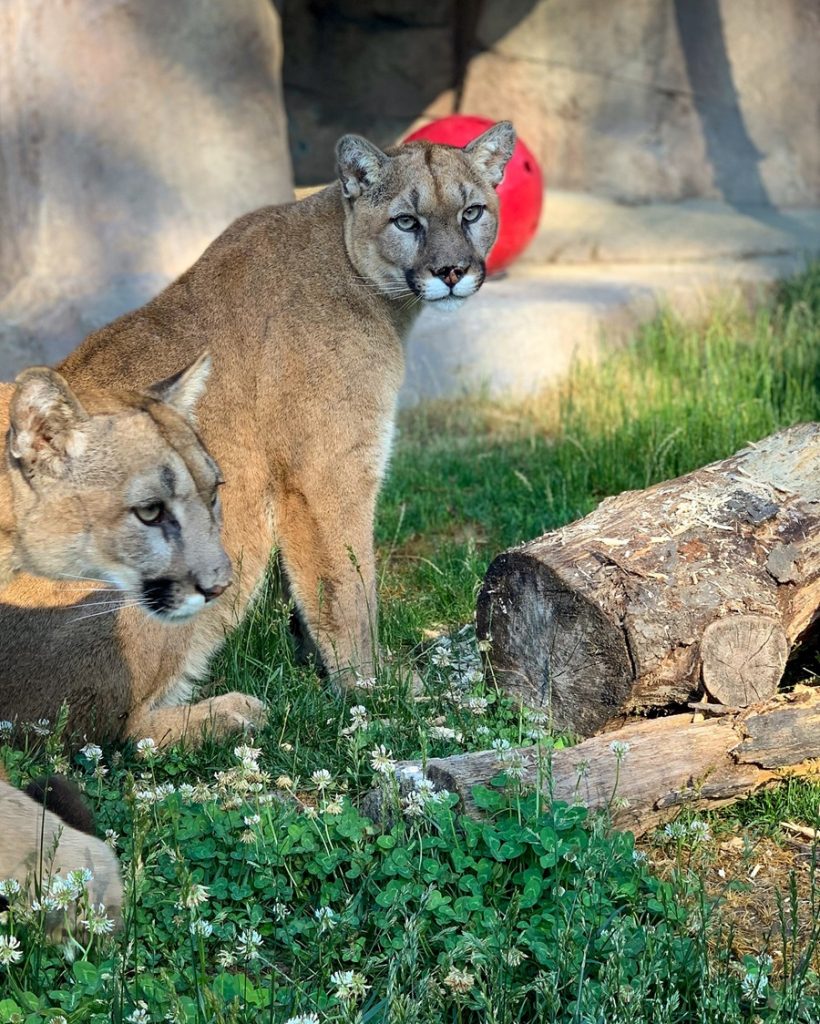VISIT THE ECOTARIUM RAIN OR SHINE

Two mountain lions and several native bird species are at the center of Wild Cat Station, a new spectacular outdoor exhibit. Grass, trees, and rocky alcoves allow the cats to utilize their natural abilities of climbing, scratching and jumping.
Wild Cat Station
One of the Largest Mountain Lion Exhibits in New England
At the heart of Wild Cat Station, presented by The Hanover Insurance Group Foundation, is a dramatic and intimate experience of a set of mountain lions in their natural New England habitat. Utilizing and transforming the former polar bear habitat, the sibling cats are home in their re-created mountainous terrain while visible from multiple viewing angles by our visitors.
The brother and sister kittens were found emaciated and orphaned in Half Moon Bay, California and brought to Oakland Zoo for vet care. The EcoTarium worked with the zoo through Massachusetts Division of Fisheries and Wildlife for safe transport of the cats.
An exciting part of the new exhibit is how the mountain lion kittens were named: the male name was auctioned off at EcoTarium’s signature fundraiser A Night at the Museum held on April 27, 2019. “Salton” was chosen; it is a combination of the two last names of the winning bidders. Female mountain lion-naming rights were first extended to EcoTarium members, the public was given the opportunity to vote on their narrowed-down list. “Freyja” is the female name after a close race.
The habitat is one of the largest mountain lion exhibits in the U.S. at 18,500 square feet and meets all accreditation standards and USDA requirements to house large carnivores. It is comprised of grass, trees, logs and rocky alcoves and outcroppings that allow the cats to utilize their natural abilities of climbing, scratching and jumping in the exhibit. The habitat was designed with all four seasons in mind and includes a conditioned space to house the cats inside at night and during inclement weather events. EcoTarium keepers have multiple access points and a training staging area. In the near future, museum guests will have the ability to observe training sessions with the mountain lions. Wild Cat Station completes the final project in Phase II of the museum’s Third Century Plan.
Named the Arthur M. and Martha R. Pappas Educational Plaza for their foundation’s generous contribution, the expanded outdoor space serves as an essential platform for educational programming for schools, educators and for curious visitors.
Mountain Lions: Did You Know…
Status: Least concern (two subspecies- the Florida panther and Costa Rican panther are considered endangered)
Population estimate: Difficult to estimate precisely due to the elusive and wide-ranging nature of the species- United States population is unlikely to exceed 30,000; current established populations are in 14 western states, Florida, western Canada, Mexico, Central and South America
Average weight: Males range typically from 110-180 pounds, females 80-130
Average length: Males 6-8 feet/ females 5-7 feet from nose to tip of tail
Average lifespan: 10 years in their natural habitat, 20 under human care
Diet in their natural habitat: opportunistic hunters- deer, elk, moose, bighorn sheep, rabbits, rodents, raccoons, feral hogs, porcupines
Diet at the EcoTarium: Specially formulated large feline diet, and non-living rodents, rabbits, chicken, and fish

How did our cats get here?
• Mountain lions are not currently bred under human care in respected zoological institutions- instead kittens come under human care as orphaned individuals. Most kittens have been orphaned because of factors such as car strikes, forest fires and other natural disasters, as well as hunting.
• Federal and state agencies often are the initial locaters of abandoned kittens. Fish and Wildlife agencies will do their best to observe kittens and track a mother cougar before removing them from their natural habitat.
• Orphaned kittens would be unable to survive in their first year of life without the initial care and necessary learning skills that a mother provides.
Are there mountain lions in Massachusetts?
• The last eastern mountain lion in Massachusetts was sighted in 1858.
• There have been three documented confirmations of mountain lions in Massachusetts since 1990.
• Two have been in Worcester County and one in Franklin County. These were confirmed by scat/ DNA analysis, not official sightings.
Interesting facts about mountain lions:
• The mountain lion is the only large cat on the planet not dwindling in numbers.
• Once thought to be completely solitary, recent research shows evidence of social family groups, females raising young together and females accepting males to share a kill with her kittens.
• They are opportunistic, stalk-ambush predators that surprise their prey from behind and crush the throat in a swift kill.
• Mountain lions are crepuscular – they hunt and are generally most active around dusk and dawn; their pupils are rounder than a domestic cat’s, whose pupils close into those distinctive slits during the daytime.
• Known for stealth and athleticism.
• Bound up to 40 feet running.
• Can leap 15 feet vertically.
• Can travel 10 mph for several miles and reach speeds up to 50 mph.

THE WORCESTER ECOTARIUM

